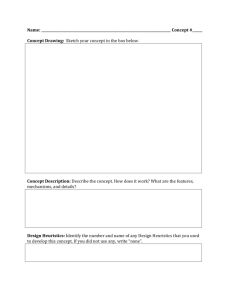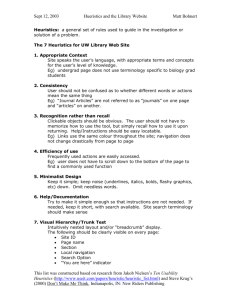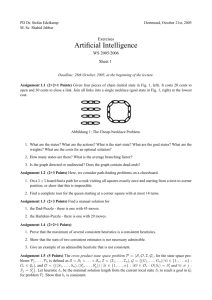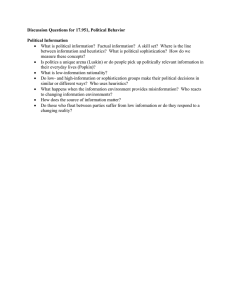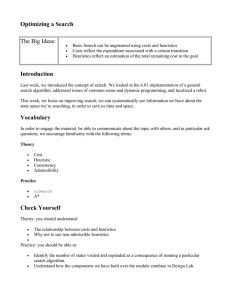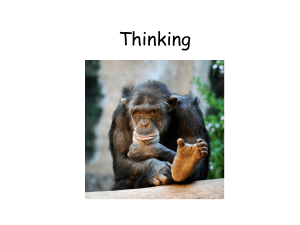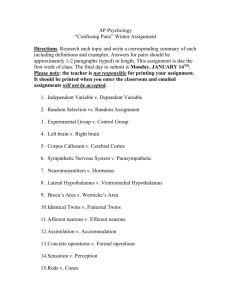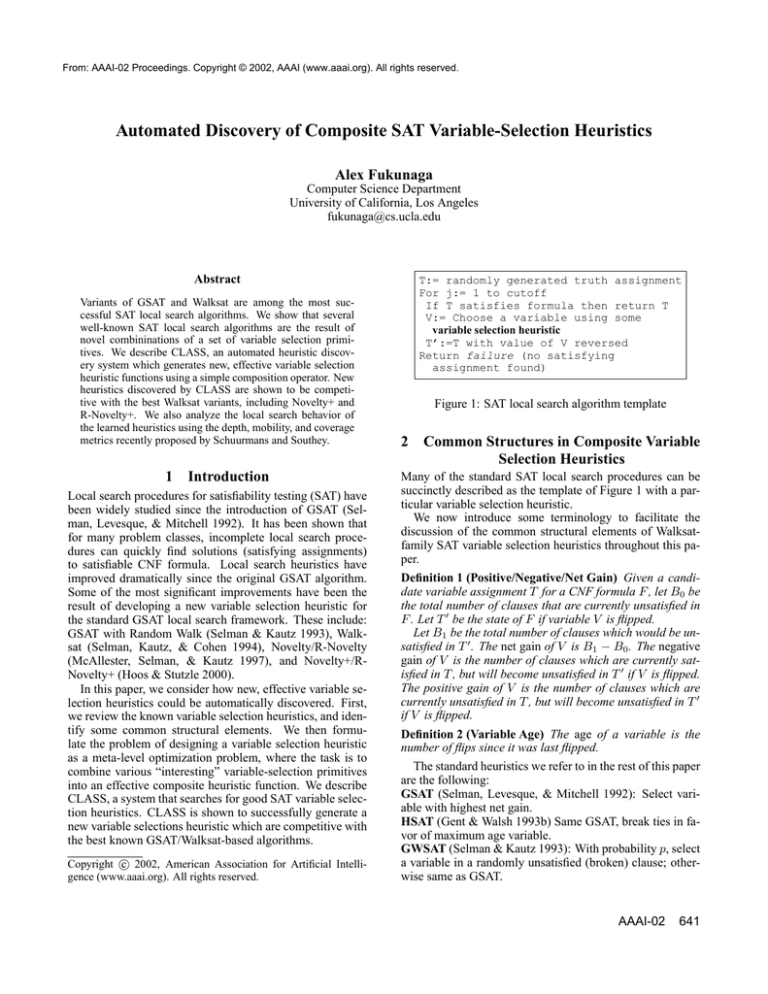
From: AAAI-02 Proceedings. Copyright © 2002, AAAI (www.aaai.org). All rights reserved.
Automated Discovery of Composite SAT Variable-Selection Heuristics
Alex Fukunaga
Computer Science Department
University of California, Los Angeles
fukunaga@cs.ucla.edu
Abstract
Variants of GSAT and Walksat are among the most successful SAT local search algorithms. We show that several
well-known SAT local search algorithms are the result of
novel combininations of a set of variable selection primitives. We describe CLASS, an automated heuristic discovery system which generates new, effective variable selection
heuristic functions using a simple composition operator. New
heuristics discovered by CLASS are shown to be competitive with the best Walksat variants, including Novelty+ and
R-Novelty+. We also analyze the local search behavior of
the learned heuristics using the depth, mobility, and coverage
metrics recently proposed by Schuurmans and Southey.
1 Introduction
Local search procedures for satisfiability testing (SAT) have
been widely studied since the introduction of GSAT (Selman, Levesque, & Mitchell 1992). It has been shown that
for many problem classes, incomplete local search procedures can quickly find solutions (satisfying assignments)
to satisfiable CNF formula. Local search heuristics have
improved dramatically since the original GSAT algorithm.
Some of the most significant improvements have been the
result of developing a new variable selection heuristic for
the standard GSAT local search framework. These include:
GSAT with Random Walk (Selman & Kautz 1993), Walksat (Selman, Kautz, & Cohen 1994), Novelty/R-Novelty
(McAllester, Selman, & Kautz 1997), and Novelty+/RNovelty+ (Hoos & Stutzle 2000).
In this paper, we consider how new, effective variable selection heuristics could be automatically discovered. First,
we review the known variable selection heuristics, and identify some common structural elements. We then formulate the problem of designing a variable selection heuristic
as a meta-level optimization problem, where the task is to
combine various “interesting” variable-selection primitives
into an effective composite heuristic function. We describe
CLASS, a system that searches for good SAT variable selection heuristics. CLASS is shown to successfully generate a
new variable selections heuristic which are competitive with
the best known GSAT/Walksat-based algorithms.
c 2002, American Association for Artificial IntelliCopyright °
gence (www.aaai.org). All rights reserved.
T:= randomly generated truth assignment
For j:= 1 to cutoff
If T satisfies formula then return T
V:= Choose a variable using some
variable selection heuristic
T’:=T with value of V reversed
Return failure (no satisfying
assignment found)
Figure 1: SAT local search algorithm template
2 Common Structures in Composite Variable
Selection Heuristics
Many of the standard SAT local search procedures can be
succinctly described as the template of Figure 1 with a particular variable selection heuristic.
We now introduce some terminology to facilitate the
discussion of the common structural elements of Walksatfamily SAT variable selection heuristics throughout this paper.
Definition 1 (Positive/Negative/Net Gain) Given a candidate variable assignment T for a CNF formula F , let B0 be
the total number of clauses that are currently unsatisfied in
F . Let T 0 be the state of F if variable V is flipped.
Let B1 be the total number of clauses which would be unsatisfied in T 0 . The net gain of V is B1 − B0 . The negative
gain of V is the number of clauses which are currently satisfied in T , but will become unsatisfied in T 0 if V is flipped.
The positive gain of V is the number of clauses which are
currently unsatisfied in T , but will become unsatisfied in T 0
if V is flipped.
Definition 2 (Variable Age) The age of a variable is the
number of flips since it was last flipped.
The standard heuristics we refer to in the rest of this paper
are the following:
GSAT (Selman, Levesque, & Mitchell 1992): Select variable with highest net gain.
HSAT (Gent & Walsh 1993b) Same GSAT, break ties in favor of maximum age variable.
GWSAT (Selman & Kautz 1993): With probability p, select
a variable in a randomly unsatisfied (broken) clause; otherwise same as GSAT.
AAAI-02
641
Walksat (Selman, Kautz, & Cohen 1994): Pick random broken clause BC from F . If any variable in BC has a negative
gain of 0, then randomly select one of these to flip. Otherwise, with probability p, select a random variable from BC
to flip, and with probability (1 − p), select the variable in
BC with minimal negative gain (breaking ties randomly).
Novelty (McAllester, Selman, & Kautz 1997): Pick random
unsatisfied clause BC. Select the variable v in BC with
maximal net gain, unless v has the minimal age in BC. In
the latter case, select v with probability (1 − p); otherwise,
flip v2 with second highest net gain.
Novelty+ (Hoos & Stutzle 2000): Same as Novelty, but after
BC is selected, with probability pw , select random variable
in BC; otherwise continue with Novelty.
R-Novelty (McAllester, Selman, & Kautz 1997) and RNovelty+ (Hoos & Stutzle 2000) are similar to Novelty and
Novelty+, but more complicated (we omit their description
due to space constraints).
Based on the descriptions above, it is clear that these
heuristics share some significant structural (syntactic) features:
2.1
Common Primitives
All of the above heuristics combine a number of “selection
heuristic primitives” into a single decision procedure. These
conceptual primitives are the following:
Scoring of variables with respect to a gain metric: Variables are scored with respect to net gain or negative gain.
Walksat uses negative gain, while GSAT and the Novelty
variants use net gain. Restricting the domain of variables:
Whereas GSAT allows the selection of any variable in the
formula, Walksat and Novelty variants restrict the variable
selection to a single, randomly selected unsatisfied clause.
Ranking of variables and greediness: The variables in
the domain are ranked with respect to the scoring metric. Of
particular significance is the best (greedy) variable, which is
considered by all of the heuristics. Novelty also considers
the second best variable.
Variable age: The age of a variable is the number of flips
since a variable was last flipped. This historical information
seems to be useful for avoiding cycles and forcing exploration of the search space. Age used by the Novelty variants,
as well as HSAT. Walksat with a tabu list was also evaluated
in (McAllester, Selman, & Kautz 1997).
Conditional branching: In most of the heuristics, some
simple Boolean condition (either a random coin toss or a
function of one or more of the primitives listed above) is
evaluated as the basis for a branch in the decision process.
Compact, nonobvious combinatorial structure: All of
the heuristics can be implemented as relatively simple functions built by composing the various primitives discussed
above. Even R-Novelty, which is the most complex of the
above heuristics, can be represented as a 3-level decision diagram (Hoos & Stutzle 2000).
For all except possibly the simplest GSAT variants, it is
difficult to determine a priori how effective any given heuris-
642
AAAI-02
tic is. Empirical evaluation is necessary to evaluate complex heuristics. For example, although there are many possible heuristics that combine the elements of Walksat (random walk, some greediness, localization of the variable domain to a single randomly selected broken clause), the performance of Walksat-variants varies significantly depending
on the particular choice and structural organization of these
“Walksat elements”. Furthermore, significant performance
differences between superficially similar local search heuristics can not be eliminated by merely tuning control parameters. See, for example, the comparison of Walksat/G, Walksat/B, and Walksat/SKC in (McAllester, Selman, & Kautz
1997).
3 CLASS: A System for Discovering
Composite Variable Selection Heuristics
How can we discover new, effective variable selection
heuristics? Some existing heuristics were a result of a focused design process, which specifically addressed a weakness in an existing heuristic. GWSAT and Novelty+ added
random walk to GSAT and Novelty after observing behavioral deficiencies of the predecessors (Selman & Kautz
1993; Hoos & Stutzle 2000). However, some major structural innovations involve considerable exploratory empirical
effort. For example, (McAllester, Selman, & Kautz 1997)
notes that over 50 variants of Walksat were evaluated in their
study (which introduced Novelty and R-Novelty).
It appears that although human researchers can readily
identify interesting primitives (Section 2) that are relevant
to variable selection the task of combining of these primitives into composite variable selection heuristics may benefit from automation. We therefore developed a system
for automatically discovering new SAT heuristics, CLASS
(Composite heuristic Learning Algorithm for SAT Search).
The main components of CLASS are:
• A minimal language for expressing variable selection
heuristics s-expressions, and
• A population-based search algorithm that searches the
space of possible selection heuristics by repeated application of a composition operator.
CLASS represents variable selection heuristics in a Lisplike s-expressions language. In each iteration of the local
search (Figure 1), the s-expression is evaluated in place of
a hand-coded variable selection heuristic. To illustrate the
primitives built into CLASS, Figure 2 shows some standard
heuristics represented as CLASS s-expressions (See Appendix and Section 3.1 for language primitive definitions).
The space of possible s-expressions expressible in our language is obviously enormous, even if we bound the size of
the expressions. Furthermore, we currently lack principled,
analytical meta-heuristics that can be used to guide a systematic meta-level search algorithm. Therefore, CLASS uses a
population-based search algorithm to search for good variable selection heuristics (Figure 3).
The Initialize function creates a population of randomly generated s-expressions. The expressions are generated using a context-free grammar as a constraint, so that
GSAT with Random Walk (GWSAT):
(If (rand 0.5)
RandomVarBC0
VarBestNetGainWFF)
Walksat:
(IfVarCond == NegGain 0
VarBestNegativeGainBC0
(If (rand 0.5)
VarBestNegativeGainBC0
RandomVarBC0))
Novelty:
(IfNotMinAge BC0
VarBestNetGainBC0
(If (rand 0.5)
VarBestNetGainBC0
VarSecondBestNetGainBC0))
Figure 2: Walksat, GSAT with Random Walk, and Novelty
represented in the CLASS language.
Initialize(population,populationsize)
For I = 1 to MaxIterations
Pick parent1 and parent2 from population
Children = Composition(parent1,parent2)
Evaluate(Children)
Insert(Children,Population)
Figure 3: CLASS Meta-Search Algorithm
each s-expression is guaranteed to be a syntactically valid
heuristic that returns a variable index when evaluated. The
Pick function picks two s-expressions from the population,
where the probability of selecting a particular s-expression
is a function of its rank in the population according to its
objective function score (the higher an expression is ranked,
the more likely it is to be selected). The composition operator (detailed below) is applied to the parents to generate a
set of children, which are then inserted into the population.
Each child replaces a randomly selected member of the population, so that the population remains constant in size (the
lower the ranking, the more likely it is that an s-expression
will be replaced by a child). The best heuristic found during
the course of the search is returned.
3.1 The composition operator
Recall that GWSAT and Novelty+ were derived by adding
random walk to GSAT and Novelty. This can be generalized into a general meta-heuristic for creating new variable
selection strategies: Given two heuristics H1 and H2 , combine the two into a new heuristic that chooses between H1
and H2 using the schema:
If Condition H1 else H2
where Condition is a Boolean expression.
We call this the composition operator. Intuitively, this is
a reasonable meta-heuristic because it “blends” (switches
between) the behavior of H1 and H2 according to some
boolean condition. The special case where Condition is a
randomization function (i.e., If (rnd<p) then ...) is a
probabilistic composition.
Probabilistic composition has a desirable theoretical property. Hoos (Hoos 1998) defines a SAT local search procedure to be PAC (approximately correct) if with increasing run-time the probability of finding a solution for a satisfiable instance approaches one. An algorithm that is not
PAC is called essentially incomplete. GSAT, Novelty, and
R-Novelty were shown to be essentially incomplete; however, their performance is significantly improved by adding
random walk, which was proven to make these algorithms
PAC (Hoos 1998). That is, the historical process by which
GWSAT and Novelty+ were generated can be modeled as
an application of probabilistic composition. The composition operator has the generalization of this formal property:
Property 1 Let H1 and H2 be two variable selection
heuristics. If (without loss of generality) H1 is PAC, then
the composite heuristic (If (rnd p) then H1 else
H2 ), which is the result of applying the probabilistic composition operator is also PAC for all p > 0. [Proof: follows
from the fact that as long as p > 0, there is a sequence of
coin flips which continues to choose H1 ]
Thus, during the discovery process, if we have a heuristic whose major deficiency is essential incompleteness, then
probabilistic composition with any PAC heuristic in the population theoretically removes that deficiency.
The full composition operator used by CLASS takes two
heuristics s-expressions H1 and H2 as input and outputs the
10 new heuristics to be inserted into the population:
• Five probabilistic compositions of the form (If (rnd
p) H1 H2 ), for p=0.1, p=0.25, p=0.5, p=0.75, and
p=0.9
• (OlderVar H1 H2 ) - evaluates H1 and H2 , and returns the variable with maximal age.
• (IfTabu 5 H1 H2 ) - Let variable v be the result of
H1 . If age(v) is tabu (i.e., less than 5), then evaluate H2 .
• (IfVarCond == NegativeGain 0 H1 H2 ) Let v1 be the result of H1 . if N egativeGain(v1 ) = 0
return v1 , else return v2 , the result of H2 .
• (IfVarCompare <= NegGain H1 H2 )
Let v1 be the results of H1 , v2 the result of H2 .
If N egativeGain(v1 ) is less than or equal to
N egativeGain(v2 ), then return v1 , else v2 .
• (IfVarCompare <= NetGain H1 H2 ) - same as
above, but uses net gain as the comparator.
3.2
Evaluating the utility of a candidate heuristic
The Evaluate function in Figure 3 evaluates the utility
of a candidate s-expression on a set of training instances.
We selected the class of hard, randomly generated 3-SAT
problem instances (Mitchell, Selman, & Levesque 1992) as
our training set. First, the heuristic was run on 200 satisfiable, 50 variable, 215-clause random 3-SAT instances, with
a cutoff of 500 flips. If more than 130 of these descents
AAAI-02
643
(If (rand 0.5)
(If (rand 0.25)
(IfVarCompare > NetGain
VarBestNetGainBC0
(OlderVar VarBestNegativeGainBC1
VarBestNegativeGainBC0))
(OlderVar (OlderVar
VarBestNegativeGainBC0
(IfVarCond == NegativeGain 0
VarBestNegativeGainBC0
RandVarBC0))
VarBestNegativeGainBC1))
(If (rand 0.1)
(If (rand 0.5) VarBestNetGainWFF
VarRandomWFF)
(OlderVar VarBestNegativeGainBC1
VarBestNegativeGainBC0)))
Figure 4: CH1, a heuristic learned by CLASS
was successful, then the heuristic was run for 2000 satisfiable, 100-variable, 430-clause random 3-SAT instances
with a 4000 flip cutoff. The score of an individual is: (#
of 50-var successes) + (5 * (# of 100-var successes)) + (
1/M eanF lipsInSuccessf ulRuns)
Although the purpose of this scoring function design is
to train heuristics on 100-variable problems, the 50-variable
problems serve as a filter that quickly identifies very poor individuals and saves us from evaluating the large set of 100variable problems. Nevertheless, this is a relatively expensive objective function, which can require up to a minute
of computation for some individuals on a 500-Mhz Pentium
III machine (largely due to inefficiencies in our implementation). We have experimented with using only smaller problem instances in the objective function, but in preliminary
studies, we found that heuristics generated using only 25
and 50-variable instance training sets did not scale when executed on 100-variable problem instances (this is because
on extremely small problems, it is difficult to distinguish the
performance between mediocre heuristics and good heuristics, so the discovery algorithm receives insufficient bias).
The heuristic CH1 (Figure 4) was the best heuristic discovered in a CLASS run using a population of 300, after
3000 candidate expressions were generated and evaluated.
Another heuristic, CH2 (not shown due to space constraints)
was discovered in a run with population 400 and 5000 evaluations. Both CH1 and CH2 will be empirically evaluated below. Heuristics of similar quality can be reliably generated
in a 5000 evaluation run. However, since each run of CLASS
currently takes several days on a Pentium III-500MHz machine, we have not yet had the resources to perform a statistically meaningful study of learning algorithm performance.
3.3
CLASS-L: Extensions to the algorithm
In order to improve the quality of the heuristics discovered
by CLASS, we introduced two enhancements, resulting in
the CLASS-L system. Rather than relying on a completely
random initial population to serve as the building blocks of
644
AAAI-02
(If (rand 0.10)
(NovSchema BC1 NegativeGain 0.50)
(OlderVar
(If (rand 0.10)
(IfVarCond == NegativeGain 0
(If (rand 0.25)
VarBestNetGainBC0
(RNovschema BC1
NetGain 0.60))
(If (rand 0.10)
VarSecondBestNegativeGainWFF
(Select2Rank PositiveGain
NetGain)))
(IfTabu age5
(RNovSchema BC1 NetGain 0.40)
(If (rand 025)
VarRandomBC0
VarBestNegGainBC1)))
(IfTabu age5
(RNovSchema BC1 Net 0.40)
(If (rand 0.25)
(NovSchema BC0 Negative 0.45)
(If (rand 0.25)
VarBestNegativeGainBC1
VarBestNetGainBC0)))))
Figure 5: CLH1, a heuristic discovered by CLASS-L
the composed heuristics, it is intuitive to attempt to help
the learning system by providing “good” building blocks.
We therefore added a library of hand-selected s-expressions.
The library is used as follows. CLASS-L still generates
a random population, but in addition, it loads the library
into a separate array. The new CLASS-L selection function, with probability pL , picks an individual from the library, instead of the population; otherwise, it picks an individual from the population. Currently, the library consists of 50 s-expressions, including encodings of all of the
standard heuristics (GSAT, GWSAT, all the Walksat variants
in (McAllester, Selman, & Kautz 1997), Novelty, and RNovelty), as well as s-expressions which perform poorly by
themselves but were believed to be possibly useful as building blocks. In addition, we added two new primitives so
that we could compactly represent variants of Novelty and
R-Novelty:
(NovSchema clause gaintype Pnoise ) - executes the Novelty decision procedure on the given clause
as defined in (McAllester, Selman, & Kautz 1997), using
Pnoise as the noise parameter. Instead of using only net
gain (as done by the version presented in (McAllester, Selman, & Kautz 1997), any gain metric can be used depending
on gaintype. For example, the standard Novelty heuristic is
(NovSchema BC0 netgain 0.5).
(RNovSchema clause gaintype Pnoise ) - similar to NovSchema, but executes the R-Novelty decision process schema. Using CLASS-L, we generated a new variable
selection heuristic, CLH1 (Figure 5) after a 400-population
run which generated 6000 candidate heuristcs.
4 Experimental Results
We empirically evaluated the automatically discovered
heuristics CH1, CH2, and CLH1, using a set of standard
SAT local search benchmark instances. The experimental
design is similar to that of (Schuurmans & Southey 2001).
For comparison, the results of Walksat with noise parameter 0.5, Novelty with a noise parameter of 0.5, and Novelty+
with noise parameter 0.5 and random walk probability 0.01)
taken from (Schuurmans & Southey 2001) are shown in Table 1
All of the benchmark instances in this paper were obtained from SATLIB (www.satlib.org). Failure % is the percentage of runs which terminated without finding a solution;
flips is the mean number of flips used by the runs which succeeded.
4.1
Evaluation of Learned Heuristic vs. Standard
Local Search Heuristics
Performance vs. Test instances from Target Distribution
Recall that CLASS uses a training set of 50 and 100 variable
random 3-SAT instances as the training instances during the
learning process. We first evaluated the performance of the
learned heuristics on test instances from the same problem
problem class as the training instances (the 1000 instances in
the uf100-430 benchmark set). To evaluate how the learned
heuristics performed relative to the best hand-coded heuristics on the target distribution, we first needed to find the best
control parameter values for the best standard heuristics. We
tuned R-Novelty by varying the noise parameter at 0.01 increments, and we also tuned R-Novelty+ by varying both
the noise parameter and the random walk parameter at 0.01
increments, and measuring their performance on 100 independent runs on the 1000 uf100-430 benchmark instances.
We found that R-Novelty with a noise setting of 0.68 had
the best performance (with a cutoff of 500,000 flips; mean
of 100 runs per instance). As shown on Table 1, the performance of CH1 and CH2, which were generated by CLASS,
is competitive with all but the highly tuned R-Novelty(0.68).
CLH1, which was generated by CLASS-L, actually outperforms R-Novelty(0.68).
Generalization and Scaling We have already shown that
the learned heuristics are capable of some generalization,
since they performed well on the uf100-430 instances, which
are different problem instances than the problems in the
training set (although they are from the same abstract class
of 100 variable, 430 clause random generate 3-SAT problems).
Next, we evaluated the learned heuristics (and also the
tuned R-Novelty(0.68)) on benchmarks from different problem classes to see how well the heuristics generalized and
scaled beyond the test distribution for which they were
specifically trained. As shown in Table 1, CH1 CH2, and
CLH1 scaled and generalized well on larger hard 3-SAT instances from the phase-transition region (uf150, uf200, and
uf250, which are 150-250 variable instances). They generalized fairly well to the graph-coloring and All-Interval-Series
instances (flat125, ais6, 8, 10). CLH1 also generalized well
on the planning instances (medium, huge, bw large(a-c),
GWSAT
Walksat
R-Novelty
CLH1
CH1
CH2
successes
285
902
987
989
958
952
flips
4471
2151
1101
1045
1624
1771
depth
7.998
6.965
8.232
7.892
7.30
7.08
mobility
11.6829
14.5036
23.237
22.468
18.42
20.505
coverage
0.00007854
0.0004819
0.001183
0.001249
0.000789
0.000882
Table 2: Local search characteristics of learned and standard
heuristics (100 instances, 10 runs, cutoff=10000)
and logistics.c), but CH1 and CH2 significantly degraded on
the larger planning instances.
It is important to keep in mind that none of the heuristics (hand-coded or learned) were tuned for these other instances; we present this data in order to show how well the
learned heuristic generalizes relative to the generalization of
the tuned, hand-coded heuristics.
In order to discover heursitics which perform very well
on structured problem instances, it is likely that the training instances need to be tailored to the target class of structured instances. Research in the related area of variable
selection heuristics for systematic, Davis-Putnam-Loveland
based SAT algorithms has shown that variable selection
heuristics have various utilities depending on the class of
problems to which they are obtained.1 Nevertheless, the data
shows that traning based on hard random 3-SAT instances
is sufficient to generate heuristics with respectable performance on structured problems.
4.2
Local search characteristics of learned
heuristics
Schuurmans and Southey (Schuurmans & Southey 2001)
recently identified several metrics of local search behavior
that were shown to predict the problem solving efficiency of
standard SAT heuristics. Depth measures how many clauses
remain unsatisfied over the course of a run, Mobility measures how rapidly a search moves in the search space, and
Coverage measures how systematically the search explores
the search space (see (Schuurmans & Southey 2001) for detailed definitions of the metrics). We measured these characteristics for CH1, CH2, and CLH1 on 100 instances from the
uf100-430 benchmarks (uf100-0001 through uf100-0100,
10 runs per instance, 10,000 flips). As shown in Table 2, the
depth, mobility, and coverage characteristics of the learned
heuristics relative to the standard algorithms are consistent
with their performance.
Next, we conducted a large-scale experiment to test the
predictive power of the depth, mobility, and coverage metrics on a large sample of heuristics generated by CLASS.
1200 heuristics were chosen as follows: 400 from the population at the end of the CLASS run which produced CH2,
400 from the initial (random) population of the same run,
and 400 from the population at the end of the CLASS-L run
1
Unit propagation-based heuristics have been found to be
highly effective for random 3-SAT instances (Li & Anbulagan
1997), while simpler strategies have been found effective for structured instances (Moskewicz et al. 2001).
AAAI-02
645
Instance Set*
uf100(1000)
uf150(100)
uf200(100)
uf250(100)
medium(1)
huge(1)
logistics.c(1)
bw large.a(1)
bw large.b(1)
ais6(1)
ais8(1)
ais10(1)
flat125(100)
Walksat(0.5)
fail %
flips
0
3655
0.3
14331
2.9
41377
1.6
41049
0
1167
0
20211
42
332822
0
20336
58
377348
0
1377
0
36499
37
317323
1.5
74517
Novelty(0.5)
fail %
flips
0
3801
0.15
9573
2.5
31794
2.1
32864
0
392
0
11382
2
135382
0
9695
48
343078
92
460007
99
495003
100
n/a
3.2
91004
Novelty+(.5,.01)
fail %
flips
0
2298
0.03
8331
2.3
28529
2.2
31560
0
537
0
12419
1
163622
0
10788
53
373001
0
12031
8
169626
84
451222
0.8
37408
R-Novelty(0.68)
fail %
flips
0
1258
0
5102
2.03
19946
2.82
23849
0
332
0
12167
7
152218
0
10151
79
245243
0
7279
16
139036
73
259861
18.21
125946
CLH-1
fail %
0
0
1.67
1.47
0
0
0
0
24
0
0
60
4.63
flips
1124
4317
14533
16541
316
6454
81306
6656
186508
1413
43050
216420
71125
CH-1
fail %
0
0.09
2.08
0.96
0
0
83
0
72
0
0
34
0.94
flips
2112
8176
19162
23578
510
10901
221030
10126
223377
1001
24952
203709.8
60219
CH-2
fail %
0
0.02
2.66
1.67
0
0
23
0
46
0
0
31
0.97
flips
2205
8777
22358
28457
525
9805
203460
11803
192420
660.96
21559
184884.6
41220
Table 1: Performance on SATLIB benchmarks. Each entry is the mean of 100 runs on each instance; cutoff=500,000 flips per run.
* Number in parentheses are the # of instances in each instance set; values for Walksat, Novelty, and Novelty+ are from (Schuurmans &
Southey 2001)
which generated CH2, and. This way, we sought to sample a
wide range of heuristics, ranging from very poor (random) to
good (the population with CH2) to very good (the population
containing CLH1). Each of these heuristics was executed on
100 instances from the uf50-215 (50 variable, 215 clause)
benchmarks from SATLIB (100 runs per instance with cutoff of 1000 flips). Figures 5 shows the depth, mobility, and
coverage metrics versus the heuristic’s performance (number of successful runs). There is a very high correlation
between performance and coverage (r=0.89), and weaker
correlations with depth (r= -0.31) and mobility (r=0.138).
The weak correlations between performance and the mobility metric is caused by the large number of very bad heuristics in the randomly generated subset of heuristics which exhibit extreme reckless mobility. Without the random heuristics, the correlation increased to r=0.30. On the other hand,
the correlation between depth and performance without the
random heuristics was 0.22 (note the change in the sign of
the coefficient). Figure 6 indicates that high coverage seems
to be both a necessary and sufficient characteristic for local
search success on these random 3-SAT instances. Similarly,
for mobility and depth, there is apparently a “correct” range
of values which are necessary, although not sufficient, for
good performance.
5
Related work
Several previous systems have learned to improve the performance of constraint satisfaction systems by modifying
heuristics using what is essentially a heuristically guided
generate-and-test procedure like CLASS. MULTI-TAC
(Minton 1996) adapts generalized constraint-satisfaction
heuristics for specific problem classes. COMPOSER was
used to configure an antenna-network scheduling algorithm
(Gratch & Chien 1996). STAGE (Boyan & Moore 2000) is
a learning algorithm applied to SAT local search. STAGE
uses an on-line learning to adapt its heuristic by predicting objective function values based on features seen during the search; in contrast, CLASS is an off-line learning
system. CLASS strongly resembles a genetic programming
646
AAAI-02
(GP) system (Koza 1992). In fact, we can view the CLASS
as a heavily modified GP - specifically, a strongly-typed
(Montana 1993), steady-state GP using only a novel composition operator. Note that unlike our composition operator,
standard GP operators recombine and modify arbitrary subcomponents of the parents, and do not propagate the PAC
property. Our experiments with implementation of various
GP mutation and crossover operators in CLASS have not
been successful yet.
6 Discussion and Future Work
We have described and evaluated an automated discovery system for finding SAT local search variable selection
heuristics. It is interesting that repeated brute-force application of a single operator, composition, to randomly generated heuristics is sufficient to generate CH1 and CH2, which
are competitive with Walksat and Novelty variants. CLASSL, an extension that uses the Novelty schema as primitives,
generated CLH1, which is competitive with the best, tuned
version of the standard local search heuristics on the target problem class (100-variable random 3-SAT). All three
learned heuristics were shown to scale and generalize well
on larger random instances; generalization to other problem
classes varied.
Despite of the good performance on the benchmarks,
there is a concern that the automatically generated heuristics
might be “getting lucky”, or exploiting some bizarre, hidden
structure of the benchmarks. Measurements of the depth,
mobility, and coverage metrics show that CH1, CH2, and
CLH1 exhibit the characteristics of successful local search
algorithms as identified in (Schuurmans & Southey 2001).
The best learned heuristics seems to descend to promising regions and explore near the bottom of the objective as
rapidly (low depth), broadly (high mobility), and systematically (high coverage) as possible, compared to the standard
algorithms. In other words, there is convincing evidence that
the best learned heuristics perform well because they behave
in the way that good local search algorithms are expected to
behave (according to our current scientific understanding of
local search), and not because of some unexplainable exploitation of the benchmark instances. Furthermore, note
that with a little effort, one can study Figures 4-5 and observe that the learned heuristics encode ”reasonable” behavior.
Recent algorithms such as DLM (Wu & Wah 1999) and
SDF (Schuurmans & Southey 2001) are significantly different from the GSAT and Walksat family considered in this
paper, due to 1) clause-weightinsg and 2) objective function
metrics that go beyond the simple gain metrics identified in
Section 2. For example, SDF uses a scoring metric based on
the number of variables that satisfy each clause. Such advances in the building blocks of SAT local search algorithms
are orthogonal to the issue addressed by CLASS, which is
the problem of combining these building blocks into effective decision procedures. Future work will extend CLASS
with a clause-weighting mecshanism, as well new objective
function metrics (such as the SDF scoring function).
In our current implementation, the learned heuristic functions are slower (execute fewer flips per second) than the
standard heuristics. In principle, learned heuristics based
on primitives which only select variables from a particular
clause should not be much more expensive than Walksat,
and learned heuristics which require maintaining globally
optimal variables should not be much more expensive than
GSAT. This is because in an efficient implementation, the
complexity of a variable flip is dosminated by the incremental computation of gain values, which scales linearly with
the size of the problem (average # of clauses per variable),
while repeatedly accessing these values repeatedly in a complex selection heuristic is a constant overhead, which should
become asymptotically insignificant. In addition, although
there is currently no mechanism in CLASS to bias the system for the discovery of faster, simpler heuristics, there is
much that can be done to speed up the learned heuristics. For
example, runtime, size, and complexity could be used as part
of the scoring function for the discovery algorithm. Also,
post-processing optimizations of the heuristics is possible.
For example, in CH1, the single occurrence of the VarBestNetGainWFF primitive requires instantiation of the GSATequivalent data structures to identify the globally optimal
variable with respect to net gain, causing significant slowdown; without this symbol, CH1 would only need Walksatequivalent data structures. However, since that primtive is
only called 2.5% of the time (it is called only after 3 layers
of randomization), an optimizing postprocessor could try to
eliminate this kind of bottleneck from the heuristic while
maintaining search efficiency.
Evaluation of 1200 new heuristics generated by CLASS
with respect to depth, mobility, and coverage metrics (Schuurmans & Southey 2001) supported the conjecture that these
metrics are widely applicable for analyzing SAT local search
heuristics. In particular, the coverage rate seems to be the
most highly correlated with performance on random 3-SAT
instances. Furthermore, this result indicates that CLASS
could possibly use the metrics (particularly coverage) as a
partial proxy for actual algorithm runs in order to evaluate
candidate heuristics much faster is currently possible.
Local search algorithms are very sensitive to control pa-
rameters (McAllester, Selman, & Kautz 1997; Hoos & Stutzle 2000). CLASS currently does not explicitly perform
parameter tuning, although nested probabilistic compositions yields the equivalent in some cases (CH1 obviously
exploits this trick). While we have implemented parameter
tuning, it is currently turned off because in our current implementation, local optimization via control parameter tuning takes just as much computational resources as evaluating an entirely new heuristic; so far, the tradeoff has favored
broader exploration of the space of structures. However, using metrics such as those in (Schuurmans & Southey 2001;
McAllester, Selman, & Kautz 1997) as a proxy for complete
runs might enable fast parameter tuning.
While the surprisingly good performance of heuristics
learned by CLASS is interesting, the primary motivation of
this work is to explore an automated approach to the process
of designing composite search heuristics. Humans excel at
finding and classifying the relevant features/components that
can be used to solve problems, such the primitives identified in Section 2. Note that all of these primitives were
proposed in the literature by 1993, shortly after the introduction of GSAT - variants that used variable age, negative
gain, random walk can be found in (Gent & Walsh 1993a;
Selman & Kautz 1993). However, the task of combining
these features into effective composite heuristics appears to
be a combinatorial problem that is difficult for humans. As
evidence for this, note that Novelty was not introduced until 1997 (McAllester, Selman, & Kautz 1997). We have
shown that this task can be effectively formulated and solved
as a meta-level search problem. SAT local search algorithms have been intensely studied by many researchers for
10 years. The demonstration that a simple mechanical procedure which composes previously proposed primitives can
compete with some of the best human-designed heuristics
suggests that the problem of designing composite search
heuristics, in general, might benefit from an automated discovery system (especially for problem domains which have
not been as intensely studied as SAT).
Acknowledgments
Thanks to Rich Korf and Jason Fama for helpful discussions.
Finnegan Southey provided valuable clarifications regarding the
implementation of the coverage metric measurements.
References
Boyan, J., and Moore, A. 2000. Learning evaluation functions to
improve optimization by local search. Journal of Machine Learning Research 1(2).
Gent, I., and Walsh, T. 1993a. An empirical analysis of search in
gsat. Journal of Artificial Intelligence Research 1:47–59.
Gent, I., and Walsh, T. 1993b. Towards an understainding of hillclimbing procedures for sat. In Proceedings of National Conf. on
Artificial Intelligence (AAAI), 28–33.
Gratch, J., and Chien, S. 1996. Adaptive problem-solving for
large-scale scheduling problems: A case study. Journal of Artificial Intelligence Research 4:365–396.
Hoos, H., and Stutzle, T. 2000. Local search algorithms for
sat: An empirical evaluation. Journal of Automated Reasoning
24:421–481.
AAAI-02
647
16
25
0.005
0.0045
14
20
0.004
10
8
Coverage
0.0035
Mobility
Depth
12
15
10
0.003
0.0025
0.002
0.0015
6
5
0.001
4
0.0005
2
0
0
100
200
300
400
500
600
700
800
900
1000
0
0
100
200
300
400
Score
500
Score
600
700
800
900
1000
0
100
200
300
400
500
600
700
800
900
1000
Score
Figure 6: Average depth, mobility, and coverage rates vs. Score (# of successful runs) for 1200 automatically genserated
heuristics
Hoos, H. 1998. Stochastic local search - methods, models, applications. Ph.D. Dissertation, TU Darmstadt.
Appendix: Additional CLASS Language
Primitives
Koza, J. 1992. Genetic Programming: On the Programming of
Computers By the Means of Natural Selection. MIT Press.
List of some CLASS language primitives that appear in Fig.
2,4,5. The actual syntax of the CLASS s-expressions differs
slightly, but we present a simplified version for brevity and
clarity (see Section 3.1 and 3.3 for definitions of some other
primitives).
(rnd num) - true if random number r < num, else
returns false.
BC0 - randomly selected broken clauses. Note that BC0
refers to the same broken clause throughout an s-expression.
Also, note that the symbol BC1 refers to a different randomly selected clause.
(NegativeGain v) and (NetGain v) returns the
negative gain and net gain of variable v.
VarRandomBC0 - a random variable from broken clause
BC0
VarRandomWFF - random variable in the formula
VarBestNetGainBC0 - variable with the best net gain
in BC0.
VarBestNegativeGainBC1 - var. with best negative
gain in BC1.
VarBestNetGainWFF - the var. with best net gain in
the formula
(OlderVar v1 v2 ) - picks the var with the max age
from v1 and v2 .
(IfNotMinAge varset v1 v2 ) - if v1 does not
have minimal age among variables in a set of vars then return
v1 , else v2 .
(Select2RankWFF gaintype1 gaintype2 ) select best variable from formula according to gaintype1,
breaking ties using gaintype2.
Li, C. M., and Anbulagan. 1997. Heuristics based on unit propagation for satisfiability problems. In Proc. Intl. Joint Conf. Artificial Intelligence (IJCAI), 366–371.
McAllester, D.; Selman, B.; and Kautz, H. 1997. Evidence for
invariants in local search. In Proceedings of National Conf. on
Artificial Intelligence (AAAI), 459–465.
Minton, S. 1996. Automatically configuring constraint satisfaction problems: a case study. Constraints 1(1).
Mitchell, D.; Selman, B.; and Levesque, H. 1992. Hard and easy
distributions of sat problems. In Proceedings of National Conf.
on Artificial Intelligence (AAAI), 459–65.
Montana, D. 1993. Strongly typed genetic programming. Technical report, Bolt, Beranek and Neuman (BBN).
Moskewicz, M. W.; Madigan, C. F.; Zhao, Y.; Zhang, L.; and
Malik, S. 2001. Chaff: Engineering an efficient SAT solver. In
Design Automation Conference, 530–535.
Schuurmans, D., and Southey, F. 2001. Local search characteristics of incomplete sat procedures. Artificial Intelligence 132:121–
150.
Selman, B., and Kautz, H. 1993. Domain-independent extensions
to gsat: Solving large structured satisfiability problems. In Proc.
Intl. Joint Conf. Artificial Intelligence (IJCAI).
Selman, B.; Kautz, H.; and Cohen, B. 1994. Noise strategies
for improving local search. In Proceedings of National Conf. on
Artificial Intelligence (AAAI).
Selman, B.; Levesque, H.; and Mitchell, D. 1992. A new method
for solving hard satisfiability problems. In Proceedings of National Conf. on Artificial Intelligence (AAAI), 440–446.
Wu, Z., and Wah, B. 1999. Trap escaping strategies in discrete
lagrangian methods for solving hard satisfiability and maximum
satisfiability problems. In Proceedings of National Conf. on Artificial Intelligence (AAAI), 673–678.
648
AAAI-02

